Xeriscaping Costs 2024
Xeriscaping costs in Arizona can vary depending on several factors, but here’s a general breakdown to give you an idea:
-
Per Square Foot: This is a common way to estimate costs and typically ranges from $5 to $20 per square foot. A larger project will obviously cost more in total, but the price per square foot might go down slightly for bigger areas.
-
Materials: Plants, mulch, rocks, gravel, and edging all contribute to the cost. Here’s a tip: native, drought-tolerant plants are typically more expensive upfront but require less water in the long run, saving you money on your water bill.
-
Labor: Hiring a professional landscaper will add to the cost, but they can design and install a water-efficient xeriscape that meets your needs and budget. Expect to pay $50 to $100 per hour for landscaping services.
-
Additional Features: If you want fancy stuff like irrigation systems, lighting, or pathways, that will also increase the cost.
Here are some average costs to give you a ballpark figure:
- 500 sq ft: $2,500 – $10,000
- 1,000 sq ft: $5,000 – $20,000
- 1,500 sq ft: $7,500 – $30,000
Saving on Xeriscaping:
- DIY some work: If you’re handy, you can save money by removing old plants and installing mulch yourself.
- Choose low-cost materials: Look for native plants readily available in your area and consider recycled materials like rocks and gravel.
- Get multiple quotes: Compare prices from several landscapers before making a decision.
- Rebates: Many cities and water districts in Arizona offer rebates for xeriscaping. Check with your local government to see if you qualify.
Best Materials For Xeriscaping
The best materials for xeriscaping will depend on a number of factors, including your climate, soil conditions, and desired aesthetics. However, some general principles apply to all xeriscapes:
-
Drought-tolerant plants: These are plants that have adapted to survive with little water. They typically have deep root systems that can access water stored deep in the soil, and leaves that are coated with a waxy layer to help retain moisture. Some examples of drought-tolerant plants that are popular in xeriscapes include cacti, succulents, ornamental grasses, and native wildflowers.
- Mulch: Mulch is a layer of material that is applied to the surface of the soil. It helps to conserve water by reducing evaporation, suppress weeds, and regulate soil temperature. Organic mulches, such as wood chips or bark, also decompose over time and add nutrients to the soil. Inorganic mulches, such as gravel or rocks, are less likely to decompose and may reflect heat back up onto the soil, so they may not be the best choice for all climates.
-
Rocks and gravel: Rocks and gravel can be used to create paths, patios, and other hardscape features in a xeriscape. They also help to conserve water by reducing the amount of soil that needs to be irrigated. However, it’s important to choose rocks and gravel in light colors, as dark-colored rocks can absorb heat and make the surrounding area hotter.
Here are some additional tips for choosing materials for your xeriscape:
- Consider the size and scale of your yard. When choosing plants, rocks, and other materials, be sure to consider the size of your yard. Large plants and rocks can overwhelm a small space, while small plants and rocks may be lost in a large space.
- Think about your maintenance needs. Xeriscapes are designed to be low-maintenance, but there will still be some maintenance required. Choose plants that are relatively easy to care for and that don’t require a lot of water.
- Don’t forget about aesthetics. Your xeriscape should be both beautiful and functional. Choose plants, rocks, and other materials that you find appealing and that complement the style of your home.
If you are interested in increasing the beauty of your landscape by buying desert plants, stop by our convenient location at 33840 N. Cave Creek Rd., in Cave Creek. For customers interested in our landscaping services, give us a call at (480) 488-9455 to schedule a visit to your home.
More Articles About Xeriscaping
- Tips For Growing Indoor Cactus
- Wood Chips Vs Mulch
- Desert Landscaping Ideas
- 10 Incredible Saguaro Cactus Facts
- Where To Buy Saguaro Cactus
- How To Save A Dying Cactus
- How To Bring A Dead Palm Tree Back To Life
- Landscaping Prices In Arizona
- Landscape Boulders Cost
- How To Take Care Of A Cactus In Arizona | Gardening Tips
- Desert Shrubs
- When are the Saguaro Cactus in Bloom in AZ?
- Mulch vs Compost | Differences
- Garden Soil Vs. Potting Mix | Differences
- What Type Of Water Fountain Should I Buy?
- What is Xeriscape?
- The Benefits of Ground Covering Plants
- Desert Plants
- Common Desert Plants Found in Arizona
- Garden Water Fountains
- Types of Cactus
- Different Types of Water Fountains for Your Garden
- Desert Landscaping Phoenix
- Sonoran Desert Landscape Rocks
- Arizona Xeriscape Gardening
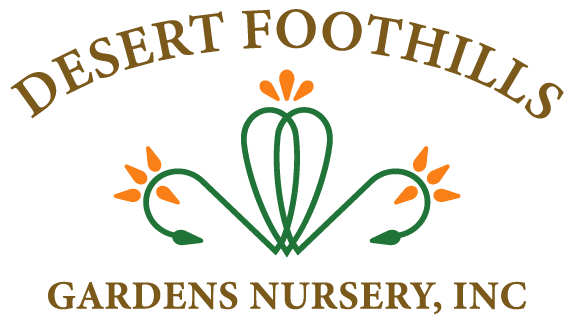


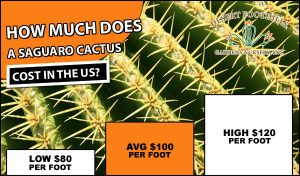
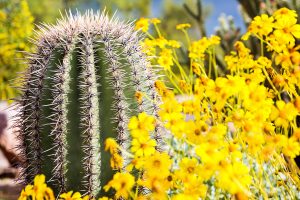
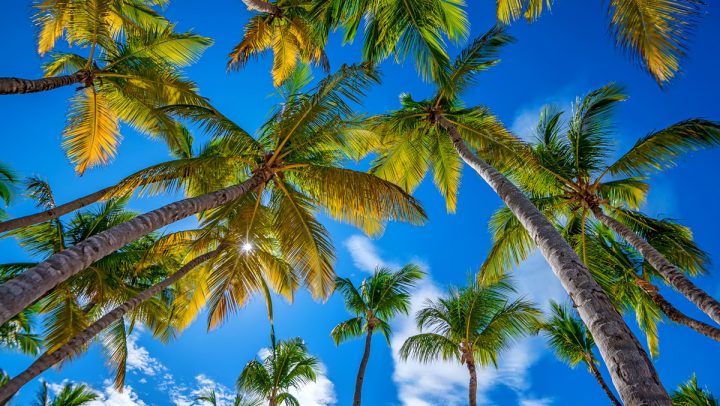
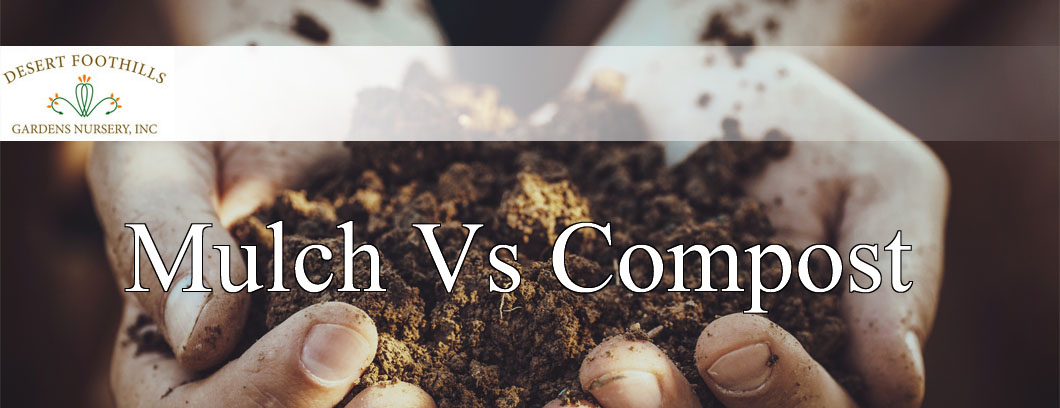

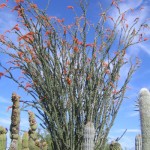 Ocotillo (Fouquieria splendens) are one of simplest plants to identify in the Sonoran desert. They are a larger shrub with elongated cane like un-branched spiky stems that grow from its short trunk. Small 2 inch leaves grow from its stems when there is enough moisture around. Thick clusters of red tube-like flowers grow from the end of its stems from March through June.
Ocotillo (Fouquieria splendens) are one of simplest plants to identify in the Sonoran desert. They are a larger shrub with elongated cane like un-branched spiky stems that grow from its short trunk. Small 2 inch leaves grow from its stems when there is enough moisture around. Thick clusters of red tube-like flowers grow from the end of its stems from March through June.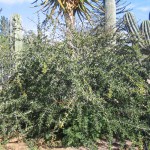 Boojum trees are a large stem succulent plant that can grow up to 54 feet high with a gently narrowing trunk, very much like that of a tall candle, up to 1-1/2 feet wide at its base. The trunk has a number of pencil-like branches with temporal leaves. On older boojum trees, its main trunk divides into two or more stems near the top of the tree which looks like the arms of an octopus. The creamy yellowish tube like flowers, bloom from July to August.
Boojum trees are a large stem succulent plant that can grow up to 54 feet high with a gently narrowing trunk, very much like that of a tall candle, up to 1-1/2 feet wide at its base. The trunk has a number of pencil-like branches with temporal leaves. On older boojum trees, its main trunk divides into two or more stems near the top of the tree which looks like the arms of an octopus. The creamy yellowish tube like flowers, bloom from July to August.
 These low-growing succulents are all identified as ice plants. Delosperma species, most of which come from South Africa, are the best ice plants for the South (they do especially well in the Sonoran desert). They usually don’t grow more than a few inches high but spread to form low growing mats ideal for covering an embankment or slope. Small daisy-like flowers, ranging purples and pinks to yellows (about 2 inches across) appear above its small, succulent leaves, which may be flat or cylindrical.
These low-growing succulents are all identified as ice plants. Delosperma species, most of which come from South Africa, are the best ice plants for the South (they do especially well in the Sonoran desert). They usually don’t grow more than a few inches high but spread to form low growing mats ideal for covering an embankment or slope. Small daisy-like flowers, ranging purples and pinks to yellows (about 2 inches across) appear above its small, succulent leaves, which may be flat or cylindrical.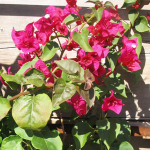 The Bougainvillea comes in many different variations. Bougainvillea loves the heat and sun and is a remarkably drought tolerant plant once rooted and stable. They bloom throughout the spring and fall seasons. While exceedingly hardy in the Sonoran desert heat, the bougainvillea can be marred by a strong frost and should be properly covered from the cold. With a plethora of colors, sizes and shapes make it a very popular landscaping plant.
The Bougainvillea comes in many different variations. Bougainvillea loves the heat and sun and is a remarkably drought tolerant plant once rooted and stable. They bloom throughout the spring and fall seasons. While exceedingly hardy in the Sonoran desert heat, the bougainvillea can be marred by a strong frost and should be properly covered from the cold. With a plethora of colors, sizes and shapes make it a very popular landscaping plant.
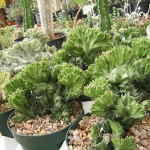 A coral cactus (euphorbia lactea crest) is clearly not a real cactus. It is actually a euphorbia plant that has a rare deviation, which causes it to grow with a crest-type appearance. Because this fascinating mutation is rare, the coral cactus is a very sought-after plant. This interesting plant closely looks like an ocean coral. It is extremely tough and needs almost no maintenance to survive. Its green and pinkish color makes it a popular choice in many landscapes, even though it can also be used to improve the appeal of the atmosphere indoors. It is a smaller plant that doesn’t grow more than 25 inches in height.
A coral cactus (euphorbia lactea crest) is clearly not a real cactus. It is actually a euphorbia plant that has a rare deviation, which causes it to grow with a crest-type appearance. Because this fascinating mutation is rare, the coral cactus is a very sought-after plant. This interesting plant closely looks like an ocean coral. It is extremely tough and needs almost no maintenance to survive. Its green and pinkish color makes it a popular choice in many landscapes, even though it can also be used to improve the appeal of the atmosphere indoors. It is a smaller plant that doesn’t grow more than 25 inches in height.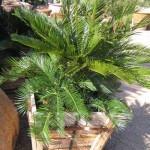

 This plant is considered rare in the US within the Anza Borrego Desert State Park region, Santa Rosa Mountains, Sonoran Desert and parts of the southwestern area of Arizona. This is a plant that is normally made to adapt to a desert climate, that has a thick trunk that will store water for days. It is small, and the branches are small when compared to the size of the trunk. It does also store water in the lower wood and limbs, apart from the trunk. The foliage on the plant is lightly distributed that has long, flat legume like leaves that are paired leaflets. The flowers on it are rounded yellow structures in bud form and will then turn into small star shaped cream or white colored flowers. Many of the species of this plant are drought deciduous because of the warm climate and will have leaves throughout the year, except during extreme cold weather and droughts.
This plant is considered rare in the US within the Anza Borrego Desert State Park region, Santa Rosa Mountains, Sonoran Desert and parts of the southwestern area of Arizona. This is a plant that is normally made to adapt to a desert climate, that has a thick trunk that will store water for days. It is small, and the branches are small when compared to the size of the trunk. It does also store water in the lower wood and limbs, apart from the trunk. The foliage on the plant is lightly distributed that has long, flat legume like leaves that are paired leaflets. The flowers on it are rounded yellow structures in bud form and will then turn into small star shaped cream or white colored flowers. Many of the species of this plant are drought deciduous because of the warm climate and will have leaves throughout the year, except during extreme cold weather and droughts. This species of cactus is found within the rocky deserts of the US and Mexico. It has narrow stems that will grow straight from a small trunk right above the ground. The stems will normally not grow into branches and then spread as they grow every year from the tip of each stem. It will take around 150 years for this plant to reach a mature stage. The older plants will produce light pink or purple tinted flowers that will have special characteristics. The flowers will stay open at night and close at the rise of the sun. The fruits that this plants produce are said to be tastier than a watermelon. They are food for many native American tribes and are also used as a medicine. The plant is pollinated by bats.
This species of cactus is found within the rocky deserts of the US and Mexico. It has narrow stems that will grow straight from a small trunk right above the ground. The stems will normally not grow into branches and then spread as they grow every year from the tip of each stem. It will take around 150 years for this plant to reach a mature stage. The older plants will produce light pink or purple tinted flowers that will have special characteristics. The flowers will stay open at night and close at the rise of the sun. The fruits that this plants produce are said to be tastier than a watermelon. They are food for many native American tribes and are also used as a medicine. The plant is pollinated by bats.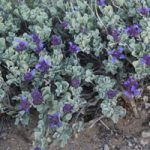 This is a beautiful shrub that ranges about 3 meters tall. The flowers on it are deep blue with purple bracts. The striking feature of this plant is that it doesn’t need to be watered once it has been established. These plants are drought resistant. They conserve solar energy and will blossom during precipitation. The plants also have medicinal properties and different tribes made infusions of stems and leaves of this plant as a cure for the common cold. It was also used to treat the flu, pneumonia, headaches, stomach aches, and some eye problems.
This is a beautiful shrub that ranges about 3 meters tall. The flowers on it are deep blue with purple bracts. The striking feature of this plant is that it doesn’t need to be watered once it has been established. These plants are drought resistant. They conserve solar energy and will blossom during precipitation. The plants also have medicinal properties and different tribes made infusions of stems and leaves of this plant as a cure for the common cold. It was also used to treat the flu, pneumonia, headaches, stomach aches, and some eye problems. This plant belongs to the aster family and is normally found in the southwestern areas of Mexico and the US. They are an annual as well as short lived perennial plants that will grow to around 30 inches tall and will have hairy leaves. These hairs help them to survive in extreme conditions by increasing light reflection, which lowers the leaf temperatures as well as blocks UV rays. The flowers on this plant will grow and are colored bright yellow, which is where their name comes from. These spring wild flowers will start blooming in March and stay in bloom until November. During the rains, these flowers will bloom more and then the stone slopes that they grow on will look like bright yellow carpets. The flowers are very poisonous and large numbers of sheep have died due to these flowers.
This plant belongs to the aster family and is normally found in the southwestern areas of Mexico and the US. They are an annual as well as short lived perennial plants that will grow to around 30 inches tall and will have hairy leaves. These hairs help them to survive in extreme conditions by increasing light reflection, which lowers the leaf temperatures as well as blocks UV rays. The flowers on this plant will grow and are colored bright yellow, which is where their name comes from. These spring wild flowers will start blooming in March and stay in bloom until November. During the rains, these flowers will bloom more and then the stone slopes that they grow on will look like bright yellow carpets. The flowers are very poisonous and large numbers of sheep have died due to these flowers.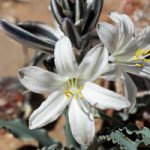 This plant is also called the Hesperocallis is a flowering plant that is found within the desert areas of North America, California, Arizona, and Mexico. These flowers are actually funnel shaped and cream colored that will bloom in March and stay until May. This plant is a common sight in deserts and the leaves around an inch wide and will grow up to 20 inches wide. When it comes to appearance, this plant looks similar to Easter Lilies. The Desert Lily has deep bulbs that will send stems early in spring and the bulb is often used as a food by Native Americans.
This plant is also called the Hesperocallis is a flowering plant that is found within the desert areas of North America, California, Arizona, and Mexico. These flowers are actually funnel shaped and cream colored that will bloom in March and stay until May. This plant is a common sight in deserts and the leaves around an inch wide and will grow up to 20 inches wide. When it comes to appearance, this plant looks similar to Easter Lilies. The Desert Lily has deep bulbs that will send stems early in spring and the bulb is often used as a food by Native Americans. This plant is also called the Chilopsis and is small, delicate deciduous shrub or tree found in Mexico and the US. The flowers for this plant bloom in May and will stay until September. The flowers are normally lavender and light pink in color. The lower lip and throat is beautifully designed to have purple lines and yellow ridges. large bees will often pollinate these flowers. It often happens in clusters and is able to deal with arid desert conditions, which certainly makes this a great desert plant.
This plant is also called the Chilopsis and is small, delicate deciduous shrub or tree found in Mexico and the US. The flowers for this plant bloom in May and will stay until September. The flowers are normally lavender and light pink in color. The lower lip and throat is beautifully designed to have purple lines and yellow ridges. large bees will often pollinate these flowers. It often happens in clusters and is able to deal with arid desert conditions, which certainly makes this a great desert plant. Palm trees often grow in subtropical, tropical humid and hot conditions, as they are not able to stand the cold. They have a variety of species which comes to just over 2600. They have long stems, which is unbranched and have clusters of long leaves at the top of stem. Palms have often remained one of the most cultivated plants till this date. Most products are often made from palm trees, so they are economical. The uses of palm trees are plentiful. edible oil is made from palm trees, coconut form palm trees, palm sap is fermented to make palm wine, as we know are very beneficial, and the coir from the outer part of coconut shells are used to make ropes, mattresses and brushes.
Palm trees often grow in subtropical, tropical humid and hot conditions, as they are not able to stand the cold. They have a variety of species which comes to just over 2600. They have long stems, which is unbranched and have clusters of long leaves at the top of stem. Palms have often remained one of the most cultivated plants till this date. Most products are often made from palm trees, so they are economical. The uses of palm trees are plentiful. edible oil is made from palm trees, coconut form palm trees, palm sap is fermented to make palm wine, as we know are very beneficial, and the coir from the outer part of coconut shells are used to make ropes, mattresses and brushes.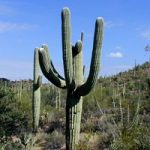 The saguaro is a species of cactus. They have long lifespans of around 150 years, but the growth depends on the precipitation amount within the desert. The spines grow rapidly, and will grow around a millimeter daily. The flowers will bloom at night and stay from April to June. The flowers are yellow and white and the ruby red fruits are eaten by locals and there are over 2000 seeds in each of them which makes it easy to pollinate. The fruits are not able to be hand-picked, because of the long spines of the tree so they have to be plucked using a long pole.
The saguaro is a species of cactus. They have long lifespans of around 150 years, but the growth depends on the precipitation amount within the desert. The spines grow rapidly, and will grow around a millimeter daily. The flowers will bloom at night and stay from April to June. The flowers are yellow and white and the ruby red fruits are eaten by locals and there are over 2000 seeds in each of them which makes it easy to pollinate. The fruits are not able to be hand-picked, because of the long spines of the tree so they have to be plucked using a long pole.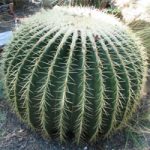 Barrel cactus happens to be the most common desert plant all over the world. It can be up to 10 meters tall and the buds on this plant will grow around April and the color will vary for each blossom. It may be pink, red, orange, or yellow. The spines on the barrel cactus need to be handled with care, because if you are pricked by one of them, you may need antibiotics to fight the effects of the barrel cactus. The plants look beautiful and are developed in nurseries or personal gardens to be an ornamental plant.
Barrel cactus happens to be the most common desert plant all over the world. It can be up to 10 meters tall and the buds on this plant will grow around April and the color will vary for each blossom. It may be pink, red, orange, or yellow. The spines on the barrel cactus need to be handled with care, because if you are pricked by one of them, you may need antibiotics to fight the effects of the barrel cactus. The plants look beautiful and are developed in nurseries or personal gardens to be an ornamental plant.